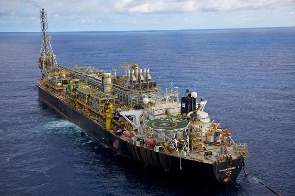The total revenue from royalties for the three oil fields in Ghana was US$302,954,860.69 in 2022 compared to US$185,683,636.46 in 2021, representing 63.2 per cent increase, the 2022 annual report of the Public Interest Accountability Committee (PIAC) had noted.
Royalties are early and dependable sources of revenues for the state as it is a charge on gross production.
Royalty from the Jubilee Field contributed 52 per cent of the total Royalties for the period, followed by SGN (32%) and TEN (16%).
Corporate Income Tax (CIT)
CIT is currently charged at a rate of 35 per cent on profits of the IOCs.
The total CIT received from the three fields in 2022 stood at US$388,889,564.00, representing 90.8 per cent increase from that of 2021 (US$203,854,804.35).
CIT constituted the second highest among the petroleum revenue streams in 2022.
The Ghana Revenue Authority (GRA) is required under Section 3 of the Petroleum Revenue Management Act, 2011 (Act 815) to assess, collect, and account for petroleum revenue due Ghana derived from royalties, corporate income tax and other defined sources.
These revenues are paid directly into the Petroleum Holding Fund (PHF) by the 15th day of the ensuing month by the entities obliged to make the payment.
For 2022, a total of US$1,428,760,076.93 accrued to the PHF from royalties, carried and participating interest (CAPI), corporate income taxes (CIT), surface rentals, and income earned on the PHF, compared to US$783,325,849.87 in 2021.
This represents 82.4 per cent increase from the 2021 figure.
The increased revenues can be attributed to favourable international crude oil prices which were higher than estimated prices, the PIAC report said.
The average achieved price by GNPC on behalf of the Ghana Group for the three producing fields increased by 52.9 per cent from US$69.180/bbl in 2021 to US$105.746/bbl in 2022.
Despite the decline in production volumes, petroleum revenues increased in 2022 by 82.4 per cent.
Receipts from Crude Liftings for Ghana Group
Receipts from crude oil liftings amounted to US$1,036,800,383.96 in 2022 as compared to US$578,613,886.90 in 2021, representing an increase of 79.2 per cent.
Receipts from Jubilee Field
Crude Liftings Six (6) liftings (64th – 69th) were made from the Jubilee Field in 2022, yielding US$567,393,883.49 in receipts, whereas five liftings recorded in 2021 yielded US$310,863,857.82.
Receipts for the period include the 63rd parcel of crude oil lifted on the 8th December, 2021 which was realised in January 2022 and excludes the 69th lifting on 17th December, 2022 whose revenues will be realised in January 2023.
The JOHL, a subsidiary of GNPC, made two (2) liftings during the year under review yielding a total of US$185,567,320.93 on the Jubilee Field.
Receipts from TEN Field
Crude Liftings for Ghana Group
One (1) lifting (21st) was made in 2022.
Total receipts from liftings in 2022 yielded an amount of US$182,370,774.69 whereas receipts for 2021 yielded US$128,723,696.70 from three (3) liftings.
Receipts for the period include the 20th Lifting from the field on 15th December, 2021 whose revenue was realised in January 2022.
The JOHL made one (1) lifting yielding an amount of US$87,084,888.02 on the TEN Field.
Receipts from Sankofa Gye-Nyame (SGN) Field Crude Liftings
There were three (3) liftings on the SGN field in 2022 with total revenues amounting to US$287,035,725.78 as compared to two (2) liftings in 2021 yielding US$139,026,332.28 in revenues. This represents a 106.5 percent increase over 2021 receipts.
JOHL Crude Oil Lifting Receipts
For the year 2022, a total amount of US$272,652,208.95 was made from JOHL’s liftings in the Jubilee and TEN fields. However, the revenue from these liftings were not part of receipts into the PHF for 2022.
Analysis of Petroleum Receipts
Carried and Participating Interest (CAPI) continues to contribute the highest percentage of total revenues followed by Corporate Income Taxes, Royalties, PHF Income, and Surface Rentals.
Carried and Participating (Additional) Interest (CAPI)
Carried and Participating Interest are two (2) forms of state participation that effectively capture its fair share of economic rents from petroleum projects regardless of whether there is initial commitment of funds by the State or not.
The revenue derived from CAPI constituted 51.4 per cent (US$733,845,523.27) of total revenues accruing from the three (3) fields as compared to US$392,930,250.44 in 2021.
This represents 86.8 per cent increase in CAPI over that of 2021.
The CAPI generated from the Jubilee Field stood at US$409,422,833.99, whilst that of TEN and SGN amounted to US$135,001,742.30 and US$189,420,946.98, respectively.
Surface Rentals
Surface Rental payments received in 2022 totaled US$687,759.16 compared with US$826,815.52 for 2021, indicating a 16.8 per cent decrease.
According to the GRA, this amount received is attributable to nine (9) out of the current fourteen (14) companies with respect to the oil blocks under their operation.
As of the end of December 2022, Surface Rental Arrears had amounted to US$2,774,066.79, up from US$2,579,170.21 as at the end of 2021, representing a 7.6 per cent increase.
Out of the Surface Rental Arrears, an amount of US$1,803,124.41, representing 65 per cent of the total arrears, relates to four (4) contractors whose Petroleum Agreements were terminated by the minister of energy in 2021.
PHF
Income Interest on the Petroleum Holding Fund yielded US$2,382,369.82 in 2022 as against US$30,343.09 in 2021.
This represents a significant increase in the interest income on the PHF (7,751%).
The significant increase was as a result of higher overnight rate on cash holdings from 0.05 per cent at start of 2022 to 4.30 per cent at end of the year.
Gas Revenue
Apart from 2015, there has been no payment into the PHF with respect to gas revenues from raw gas supplied by GNPC.
A total of 31,623.54 MMSCF of raw gas worth US$211,505,426.70, was delivered to Ghana National Gas Company (GNGC) during the period under review.
According to GNPC, total outstanding receivables from GNGC with respect to raw gas supplied amounted to US$605,691,381.479 as at the end of December 2022.
These represent revenues from gas sales that ought to be paid into the PHF.
Make-Up Gas
Make-Up Gas (MUG) for the three-year period 2018 to 2020 amounted to 35,650.45 MMSCF.
Out of the amount, 180.10 and 5,431.47 MMSCF were recovered in 2021 and 2022, respectively, leaving a balance of 30,038.88 MMSCF to be recovered in subsequent years.
According to GNPC, in 2021, due to relatively lower offtake volumes, the Annual Contract Quantity 11(ACQ) was exhausted on 30th December 2021, therefore, only 180.10 MMSCF was recovered on 31st December 2021.
However, in 2022, due to increased offtake volumes, the ACQ was achieved by 4th December, leaving about 27 days of MUG recovery which amounted to 5,451.37 MMSCF for the year.
Per the Gas Sales Agreement (GSA), the MUG for each year can be recovered within five years following the year that it was incurred, on First-In First-Out (FIFO) basis.
Thus, the total MUG taken of 5,631.47 is matched against MUG of 2018, leaving a balance of 837.57 MMSCF of 2018 to be recovered by the end of 2023.
The total invoiced amount for gas taken from the SGN Field in 2022 amounted to US$456,673,908.92.
An annual reconciliation adjustment for the 2021 delivery year as per the Gas Sales Agreement (GSA) resulted in a credit of US$1,585,904.27 to GNPC in January 2022.
This brings down the total gas invoice amount to US$455,088,004.65.
Cumulative Petroleum Revenues (2011-2022)
From 2011 to date, total petroleum revenue has amounted to US$8.79 billion.
The year 2022 has recorded the highest realised petroleum revenues into the PHF, with 2016 recording the lowest revenues.
Business News of Sunday, 23 April 2023
Source: classfmonline.com













